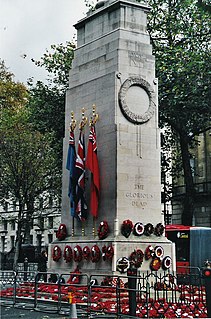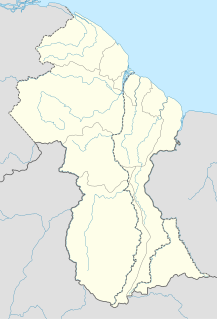Related Research Articles

Georgetown is the capital and largest city of Guyana. It is situated in Demerara-Mahaica, region 4, on the Atlantic Ocean coast, at the mouth of the Demerara River. It is nicknamed the "Garden City of the Caribbean." It is the retail and administrative and financial services centre of the country, and the city accounts for a large portion of Guyana's GDP. The city recorded a population of 118,363 in the 2012 census.

Remembrance Day is a memorial day observed in Commonwealth member states since the end of the First World War to honour armed forces members who have died in the line of duty. Following a tradition inaugurated by King George V in 1919, the day is also marked by war remembrances in many non-Commonwealth countries. In most countries, Remembrance Day is observed on 11 November to recall the end of First World War hostilities. Hostilities formally ended "at the 11th hour of the 11th day of the 11th month" of 1918, in accordance with the armistice signed by representatives of Germany and the Entente between 5:12 and 5:20 that morning. The First World War officially ended with the signing of the Treaty of Versailles on 28 June 1919.

Armistice Day is commemorated every year on 11 November to mark the armistice signed between the Allies of World War I and Germany at Compiègne, France, at 5:45 am for the cessation of hostilities on the Western Front of World War I, which took effect at eleven in the morning—the "eleventh hour of the eleventh day of the eleventh month" of 1918. But, according to Thomas R. Gowenlock, an intelligence officer with the U.S. First Division, shelling from both sides continued for the rest of the day, ending only at nightfall. The armistice initially expired after a period of 36 days and had to be extended several times. A formal peace agreement was only reached when the Treaty of Versailles was signed the following year.

Remembrance Sunday is held in the United Kingdom as a day to commemorate the contribution of British and Commonwealth military and civilian servicemen and women in the two World Wars and later conflicts. It is held on the second Sunday in November. Remembrance Sunday, within the Church of England, falls in the liturgical period of Allsaintstide.

A cenotaph is an empty tomb or a monument erected in honour of a person or group of people whose remains are elsewhere. It can also be the initial tomb for a person who has since been reinterred elsewhere. Although the vast majority of cenotaphs honour individuals, many noted cenotaphs are instead dedicated to the memories of groups of individuals, such as the lost soldiers of a country or of an empire.

The Cenotaph is a war memorial constructed in 1923 and located between Statue Square and the City Hall in Central, Hong Kong, that commemorates the dead in the two world wars who served in Hong Kong in the Royal Navy, British Army and Royal Air Force. Built in stone, it is an almost exact replica of the Cenotaph on Whitehall in London, UK. It is listed as a monument under the Antiquities and Monuments Ordinance.

The Sydney Cenotaph is a heritage-listed monument located in Martin Place, in the Sydney, Australia. It was designed by Bertram Mackennal and built from 1927 to 1929 by Dorman Long & Co. It is also known as Martin Place Memorial and The Cenotaph. It is one of the oldest World War I monuments in central Sydney. It was added to the New South Wales State Heritage Register on 11 November 2009.

Central Memorial Park is a park located in central Calgary's Beltline district. Sometimes referred to as Central Park or as Memorial Park, the area is home to the Memorial Park Library, an equestrian statue of Russell Lambert Boyle, and a cenotaph. The former Colonel Belcher Veterans Hospital was located across 4th street SW to the west, now the site of the Sheldon M. Chumir Centre. The Memorial Park Library and the surrounding park were named a National historic site in 2018

The Cenotaph War Memorial in Viharamahadevi Park, Colombo, Sri Lanka is a war memorial dedicated to the military personnel from Ceylon killed in action during the two world wars. It comprises a towering Cenotaph and Memorial Walls. The foundation stone was laid by Brigadier General Sir William Henry Manning, Governor of Ceylon on December 7, 1921 and was unveiled by him October 27, 1923 at the Galle Face Green and was known as the Victory tower. It was dismantled and re-erected at Victoria Park, during World War II after fears that the Japanese might use it as a marker to direct their artillery. The Cenotaph contains the names of those killed in the Great War, while the Memorial Wall behind it maintains the names of those killed in the Second World War. A single woman, Miss L. Midwood is listed among the dead of the Great War.

Manchester Cenotaph is a war memorial in St Peter's Square, Manchester, England. Manchester was late in commissioning a First World War memorial compared with most British towns and cities; the city council did not convene a war memorial committee until 1922. The committee quickly achieved its target of raising £10,000 but finding a suitable location for the monument proved controversial. The preferred site in Albert Square would have required the removal and relocation of other statues and monuments, and was opposed by the city's artistic bodies. The next choice was Piccadilly Gardens, an area already identified for a possible art gallery and library; but in the interests of speedier delivery, the memorial committee settled on St Peter's Square. The area within the square had been had been purchased by the City Council in 1906, having been the site of the former St Peter's Church; whose sealed burial crypts remained with burials untouched and marked above ground by a memorial stone cross. Negotiations to remove these stalled so the construction of the cenotaph proceeded with the cross and burials in situ.

The Cenotaph is a war memorial on Whitehall in London, England. Its origin is in a temporary structure erected for a peace parade following the end of the First World War, and after an outpouring of national sentiment it was replaced in 1920 by a permanent structure and designated the United Kingdom's official national war memorial.

Cove and John is located on the Atlantic coast of Guyana, 18 miles east of Georgetown and bordered by Nabacalis to the west and Victoria to the east. It has a population of 494 people as of 2012. This village has the Guyana Sevashram.

The Fremantle War Memorial is a war memorial located on Monument Hill, an 11-acre (4.45-hectare) public reserve and hill in Fremantle, Western Australia. The memorial itself comprises a large obelisk, the Fallen Soldiers' and Sailors' Memorial, surrounded by eight smaller memorials. The site, located on High Street near the centre of Fremantle, overlooks Fremantle Harbour, and was established by the Fremantle Town Council in 1928 to commemorate the losses of the First World War, having been used as a public reserve since the early 19th century.

The Gibraltar Cross of Sacrifice is a war memorial in the British Overseas Territory of Gibraltar. It is located west of North Front Cemetery, at the junction of Winston Churchill Avenue and Devil's Tower Road. The Cross of Sacrifice was designed by Sir Reginald Blomfield in 1917, and his monument is found in numerous Commonwealth War Graves Commission cemeteries. The cross in Gibraltar was erected by the Royal Engineers for the commission, and unveiled on Armistice Day 1922. The British Pathé film recorded at the dedication ceremony that day represents the first motion picture made in Gibraltar. The Gibraltar Cross of Sacrifice served as the focus of Remembrance Sunday ceremonies in Gibraltar until 2009, at which time the location was changed to the Gibraltar War Memorial.

Southport War Memorial is in London Square, Lord Street, Southport, Merseyside, England. It consists of an obelisk flanked by two colonnades in the form of Greek temples. Outside the colonnades are memorial gardens, each containing a Pool of Remembrance and fountains. The memorial was designed by the local architects Grayson and Barnish, and the carving was executed by Herbert Tyson Smith. It was unveiled in 1923 by the Earl of Derby. Following the Second World War and subsequent conflicts further inscriptions and names have been added. The memorial is recorded in the National Heritage List for England as a designated Grade II* listed building.

The Cenotaph is a war memorial on Heerengracht Street in Cape Town. The city's annual Remembrance Day ceremonies are held there. It is classified as a public memorial and as such is subject to protection in terms of heritage legislation administered by Heritage Western Cape, the provincial heritage resources authority of the Western Cape province of South Africa.

Northampton War Memorial, officially the Town and County War Memorial, is a First World War memorial on Wood Hill in the centre of Northampton, the county town of Northamptonshire, in central England. Designed by architect Sir Edwin Lutyens, it is a Stone of Remembrance flanked by twin obelisks draped with painted stone flags standing in a small garden in what was once part of the churchyard of All Saints' Church.

The National Service of Remembrance is held annually on Remembrance Sunday at the Cenotaph on Whitehall, London. It commemorates "the contribution of British and Commonwealth military and civilian servicemen and women in the two World Wars and later conflicts". The service has its origins in the 1920s and has changed little in format since.

The County Fermanagh War Memorial stands in Enniskillen, County Fermanagh, Northern Ireland. It was originally constructed to commemorate the men of the town killed during the First World War, particularly those serving with the local regiments, the 6th (Inniskilling) Dragoons and the Royal Inniskilling Fusiliers. It was later altered to also commemorate those killed in the Second World War.

The Armistice Day centenary corresponds to the date of 11 November 2018, which marks one hundred years following the signing and coming into effect of the Armistice that ended World War I on the Western Front. The centenary was marked globally, in particular across Europe, the Commonwealth and the United States, with specially-organised Armistice Day, Remembrance Day and Veterans Day commemorations, ceremonies and speeches.
References
- ↑ "November". Stabroek News. 2012-11-10. Retrieved 2021-01-06.
- ↑ "History This Week". Stabroek News. 2007-10-04. Retrieved 2021-01-06.
- ↑ "Granger calls for 'world at peace'". Stabroek News. 2015-11-09. Retrieved 2021-01-06.
- ↑ "President lauds veterans". Stabroek News. 2020-11-09. Retrieved 2021-01-06.